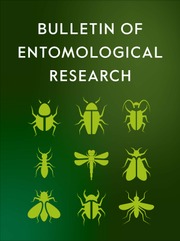No CrossRef data available.
Article contents
Some Trichoderma strains and nitrogen fertilisation impact on Cydalima perspectalis (Walker, 1859) (Lepidoptera: Crambidae) larvae
Published online by Cambridge University Press: 23 June 2025
Abstract

Cydalima perspectalis (Walker, 1859) (Lepidoptera: Crambidae) larvae feed on Buxus. It is considered to be the most critical pest of boxwood trees. This study investigated whether different strains of Trichoderma harzianum had an effect on the biocontrol of larvae feeding on boxwood leaves whose nitrogen content was varied by fertilisation. Larvae were collected while feeding on boxwood seedlings in Rize parks and gardens in June 2021. In addition, G1 (no fertilisation), G2 (1.55%), and G5 (1.67%) leaves with different nitrogen concentrations obtained by nitrogen fertilisation were also used as food. As biocontrol agents, ID11D and YP1A strains of T. harzianum were applied in three doses: 50, 100, and 200 μL per water. In total, 21 different groups were created. The nutritional indices of the larvae belonging to the different groups were calculated. In addition, the activities of phenoloxidase, superoxide dismutase, catalase, and glutathione peroxidase activities were measured by taking haemolymph samples. In both strains, the enzyme activities increased with the dose applied. However, it was found that the enzyme activities of the ID11D strain applied were higher than those of the YP1A strain. It can be said that the ID11D strain is effective in controlling C. perspectalis larvae feeding on fertilised boxwood and the YP1A strain is effective in controlling larvae feeding on unfertilised boxwood.
Keywords
Information
- Type
- Research Paper
- Information
- Copyright
- © The Author(s), 2025. Published by Cambridge University Press.


